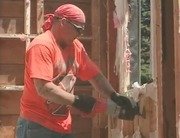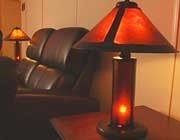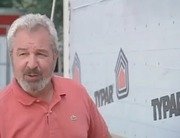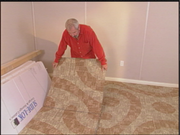Okay.
So, we've got a water heater to talk about with Dan Driscoll.
And Dan's an old friend, we've talked about these Rinnais before.
This is for the whole house, right?
This is a whole house system, Bob, this is going to replace the tank heater that was in the house.
This is a size for a 3-bathroom household.
So, this will provide laundry, cooking, dishwasher, and bathing for multiple fixtures.
It also has a feature, it's a cold start appliance, meaning it doesn't store water and it's very energy efficient.
Right.
Now, that's a very big deal in a small house, too, 'cause we're trying to capitalize on the basement space and if you had to take up an additional four square feet with a big tank, that would, you know, be a waste.
So, this really can do that, though.
I mean, you're talking three bathrooms, and this is a three bedroom house, I believe, so she could have as many as six people needing to use showers and all that, and this can supply it.
This will allow the consumer to run multiple showers in a household at the same time indefinitely.
Once we create flow, we're going to establish that flow and have that for a period of time.
Unlike a tank heater which will run low on temperature.
Right, 'cause if you...
Exactly, so how does it do it?
I mean can we look in there to see the components?
Sure, yeah.
'Cause it's a 5.3 you were saying earlier.
That's the flow rate on the unit itself.
That's the actual flow rate, 5.3 gallons per minute?
Correct, what we do is we measure the temp, then I will measure the water temperature on the inlet side .
There's a controller here on the side, that was mounted on the side of the unit.
Mm-hm.
Which the home owner can set the water temperature at.
Mm-hm.
Can that be taken remotely and put it in some other part of the house?
This could be mounted in a bathroom, in a laundry or a kitchen or a back splash...
Just grab that piece, I'll grab the other one.
Pop the cover here.
So you could theoretically alter the temperature, for example if you wanted it hotter or cooler you could
Use that remote.
An application could be, if we have children in a bathroom I could drop the water temperature to a safe level where there will never be an issue of scaling.
Right.
Ooh, they fit a lot of stuff in there, don't they?
Well, it's a little busy.
So, the water feed, let's say the cold water is coming in, we got to move the water service over to this location.
Right
And then what happens in here?
What happens is,the cold water feed makes up on IPS connection right here.
You need flow in order to initiate the burn, so we need half a gallon per minute in flow, which is about a 3/8 stream of water.
Very small volume of water.
That would be established by opening a faucet or a bath valve or a shower valve.
Once the water enters the unit, it's going to be picked up by a SMS which is a temperature sensor and then also the volume of water.
So it is measuring the volume of water and the temperature rise to what you selected for that operating temperature, then burner makes an adjustment same way a carburettor would in a car.
Where's the fuel?
The fuel is on a gas fit right here and this is our gas burner right here, it's below our heat exchanger.
So the burner is below, the water travels through these pipes, through the heat exchanger.
And this is our vent assembly, which goes to the outside for the flue gas.
OK.
So, what about cold air intake?
We use a concentric vent, which is a two pass flue pipe, which allows us to bring combustion air in, it's sealed combustion and an exhauster with a center tube.
All right.
So, this a sample of that?
Or this the actual one?
This is the termination lane that will be mounted to the outside.
So, our exhaust gas would be through this center tube and our combustion air would come in through this OD.
Now the PVC is zero clearance from combustibles, so if I had a wood frame timber, I don't have to worry about set backs.
This piece here is what I would see on the outside of the building about two inches goes to the weather.
This is our exhaust port and this is our inlet air.
It's so simple.
It's very compact.
And it's a very, I mean, energy efficiency is a big deal.
You're also saving money here, right?
Oh, this unit here with the typical gas consumption, is about a 40 percent savings.
Wow.
Over electric about 70%.
Over electric it would be like 70%.
Yeah, depending on your kilowatt rate.
But in this area it's about 70%.
We're in New England here, it's not good.
Okay, thanks Dan.
Thank you, Bob.
Alright.
Well, it's almost finished, but so we.
Next week we'll be installing heating and ventilating and air conditioning equipment as well as teaching you how to fix squeaky floors.
Until then I'm Bob Vila.
Thanks for joining us.






